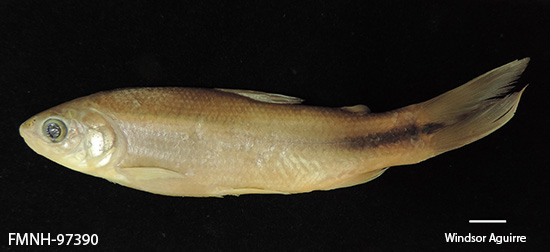| SOURCE FOR OCCURRENCE IN ECUADOR: Vari (1989), Barriga (2012), Jimenez et al. (2015). |
| ORIGINAL DESCRIPTION: Eigenmann, C.H. 1922. The fishes of western South America, Part I. The fresh-water fishes of northwestern South America, including Colombia, Panama, and the Pacific slopes of Ecuador and Peru, together with an appendix upon the fishes of the Rio Meta in Colombia. Memoirs of the Carnegie Museum v. 9 (no. 1): 1-346, Pls. 1-38. |
| TYPE SPECIMENS: |
| TAXONOMIC STATUS: Valid (Eschmeyer and Fricke, 2016). |
| RANGE ECUADOR: Macara and Catamayo Rivers close to the border between Ecuador and Peru (Vari, 1989; Jimenez et al., 2015). |
| RANGE OUTSIDE OF ECUADOR: Rio Chira and Rio Piura basins in northwestern Peru. |
| COLLECTIONS IN ECUADOR: |
| MAXIMUM SIZE: 127 mm TL (Jimenez et al., 2015). |
| DISTINGUISHING FEATURES: A discrete small spot of dark pigmentation at the base of the middle rays of the caudal fin distinguishes this species from all other species in the genus (Vari, 1989). Having 35-37 vertebrae further distinguishes this species from P. boulengeri, P. boehlkei, and P. patiae, which have 34 or fewer vertebrae. Pseudocurimata peruana can be distinguished from P. lineopunctata by having a horizontally extended dark blotch on the caudal peduncle vs. a discrete large round dark spot in the latter (Vari, 1989). |
| ECOLOGY: Very little has been published on the ecology of this species although it likely feeds on detritus like other species in the genus (Jimenez et al., 2015). |
| ECONOMIC IMPORTANCE: Unknown. |
| CONSERVATION STATUS: Unknown, although unconfirmed observations by inhabitants of the town of Zapotillo suggest that it may have decreased in abundance after construction of the Catamayo-Chira dam (Jimenez et al., 2015). |
| LINK TO FISHBASE PAGE: Click here for link |
| SPECIES PROFILE CREATED BY: Windsor Aguirre |
| SPECIES PROFILE CONTRIBUTORS: |
